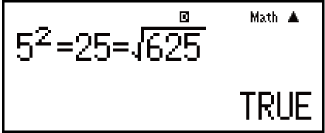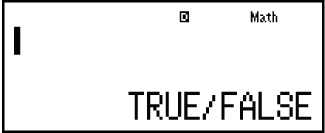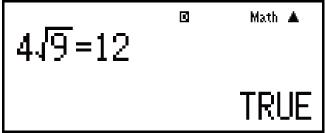fx-115ES PLUS
fx-991ES PLUS C
(2nd edition / NATURAL-V.P.A.M.)
Before Using the Calculator
Calculation Modes and Calculator Setup
Inputting Expressions and Values
- ▶Basic Input Rules
- ▶Inputting with Natural Display
- ▶√ Form Calculation Range
- ▶Using Values and Expressions as Arguments (Natural Display only)
- ▶Overwrite Input Mode (Linear Display only)
- ▶Correcting and Clearing an Expression
Basic Calculations
- ▶Toggling Calculation Results
- ▶Fraction Calculations
- ▶Percent Calculations
- ▶Degree, Minute, Second (Sexagesimal) Calculations
- ▶Multi-Statements
- ▶Using Engineering Notation
- ▶Remainder Calculations
- ▶Recurring Decimal Calculations
- ▶Prime Factorization
- ▶Calculation History and Replay
- ▶Using Memory Functions
Function Calculations
- ▶Pi (π), Natural Logarithm Base e
- ▶Trigonometric Functions
- ▶Hyperbolic Functions
- ▶Angle Unit Conversion
- ▶Exponential Functions
- ▶Logarithmic Functions
- ▶Power Functions and Power Root Functions
- ▶Integration Calculations
- ▶Differential Calculations
- ▶Σ Calculations
- ▶Π Calculations
- ▶Rectangular-Polar Coordinate Conversion
- ▶Factorial Function (!)
- ▶Absolute Value Function (Abs)
- ▶Random Number (Ran#)
- ▶Random Integer (RanInt#)
- ▶Permutation (nPr) and Combination (nCr)
- ▶Rounding Function (Rnd)
- ▶Greatest Common Divisor (GCD) and Least Common Multiple (LCM)
- ▶Integer Part of a Value (Int) and Largest Integer that does not Exceed a Value (Intg)
- ▶Using CALC
- ▶Using SOLVE
- ▶Scientific Constants
- ▶Metric Conversion
Using Calculation Modes
- ▶Complex Number Calculations (CMPLX)
- ▶Statistical Calculations (STAT)
- ▶Base-n Calculations (BASE-N)
- ▶Equation Calculations (EQN)
- ▶Matrix Calculations (MATRIX)
- ▶Creating a Numerical Table from Two Functions (TABLE)
- ▶Vector Calculations (VECTOR)
- ▶Inequality Calculations (INEQ)
- ▶Using VERIFY (VERIF)
- ▶Distribution Calculations (DIST)
Technical Information
- ▶Errors
- ▶Before Assuming Malfunction of the Calculator...
- ▶Replacing the Battery
- ▶Calculation Priority Sequence
- ▶Calculation Ranges, Number of Digits, and Precision
- ▶Specifications
- ▶Verifying the Authenticity of Your Calculator
Frequently Asked Questions
Using VERIFY (VERIF)
VERIFY is a function you can use to verify whether an input equality or inequality is true (indicated by TRUE) or false (indicated by FALSE). The following shows the general procedure for using VERIFY.
Example: To verify whether 4√9 = 12 is true (MthIO-MathO)
1. Press 

 (VERIF) to enter the VERIFY Mode.
(VERIF) to enter the VERIFY Mode.
2. Input 4√9 = 12.
4 9
9

 (VERIF)
(VERIF) (=) 12
(=) 12
You can select the equality symbol or inequality symbol from the menu that appears when you press 
 (VERIFY).
(VERIFY).
3. To verify, press  .
.
You can input the following expressions for verification in the VERIFY Mode.
Equalities or inequalities that include one relational operator 4 = √16, 4 ≠ 3, π > 3, 1 + 2 ≦ 5, (3 × 6) < (2 + 6) × 2, etc.
Equalities or inequalities that include multiple relational operators 1 ≦ 1 < 1 + 1, 3 < π < 4, 22 = 2 + 2 = 4 < 6, 2 + 3 = 5 ≠ 2 + 5 = 8, etc.
Note
The verification result will cause 1 to be assigned to Ans memory when TRUE and 0 when FALSE.
The input expression can be a total of 99 bytes, including the left side, right side, and relational operators.
Any variable (A, B, C, D, E, F, X, Y, M) input into an expression is treated as a value, using the value currently assigned to the variable.
÷R, Pol and Rec functions cannot be used in an expression.
In the VERIFY Mode, the calculator performs a mathematical operation on the input expression and then displays TRUE or FALSE based on the result. Because of this, calculation error can occur or a mathematically correct result may not be able to be displayed when the input calculation expression includes calculation that approaches the singular point or inflection point of a function, or when the input expression contains multiple calculation operations.
Expression Input Precautions
The following types of expressions cause a Syntax ERROR and cannot be verified.
An expression with nothing on the left side or right side (Example: = 5√7)
An expression in which a relational operator is inside of a fraction or function (Example: 1=12, cos (8 ≦ 9))
An expression in which a relational operator is enclosed in parentheses (Example: 8 < (9 < 10))
An expression in which multiple relational operators that are not oriented in the same direction (Example: 5 ≦ 6 ≧ 4)
An expression that contains two of the following operators in any combination (Example: 4 < 6 ≠ 8)
An expression that contains consecutive relational operators (Example: 5 ≧ > 9)
VERIFY Mode Calculation Examples
Example 1: To verify log2 < log3 < log4
 2
2

 (VERIFY)
(VERIFY) (<)
(<)
 3
3

 (VERIFY)
(VERIFY) (<)
(<)
 4
4

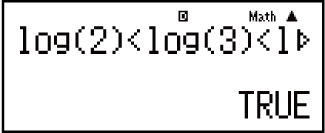
Example 2: To verify 0 < ( 89 )2 - 89 (MthIO-MathO)
- 0

 (VERIFY)
(VERIFY) (<)
(<)
8 9
9

 8
8 9
9
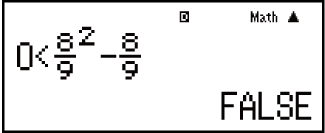
Example 3: To verify 52 = 25 = √625 (MthIO-MathO)
- 5


 (VERIFY)
(VERIFY) (=)
(=)
25
 (VERIFY)
(VERIFY) (=)
(=) 625
625
